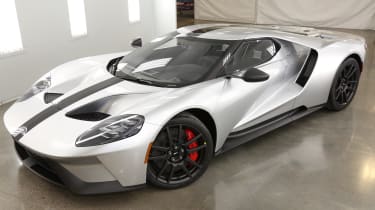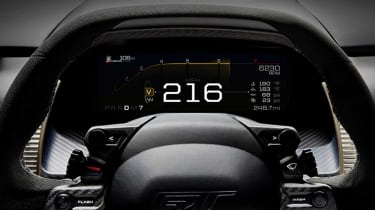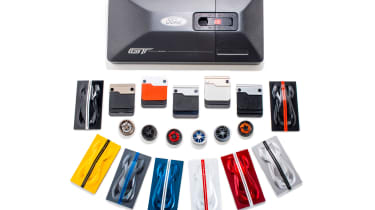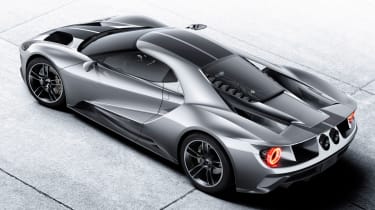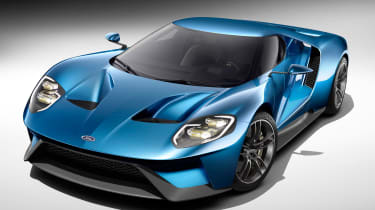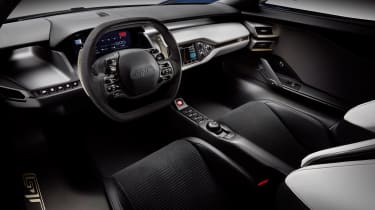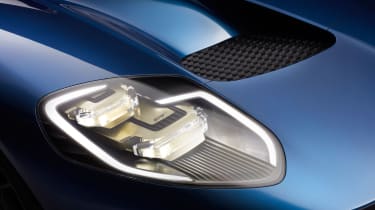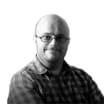2017 Ford GT: the complete story
Five drive modes, lightweight versions, top speed. Here’s all you need to know about the new Ford GT supercar.
The Ford GT was officially revealed earlier in the year, and now Ford has announced a new special-edition model of its hardcore supercar.
Dubbed the Ford GT ’67 Heritage Edition, this limited-run model is finished in a red and white livery, in homage to the Le Mans winning GT40 Mk4 of 1967.
The ’67 Heritage Edition also sports lashings of carbon fibre, 20-inch satin aluminium wheels, red brake callipers and silver wing mirrors. Inside, the ’67 Heritage Edition’s seats are upholstered in a new leather finish, picked out with red accent stitching. Red seatbelts and anodised grey shift paddles for the gearbox also feature, and Ford says “limited quantities” of the GT ’67 Heritage Edition will be built for the 2018 model year.
We've driven the standard Ford GT – read our review here.
Ford's supercar features five driving modes designed to make it as easy as possible to drive in a variety of conditions. As well as optimising the car’s electronic, mechanical and aerodynamic settings, each mode displays different information on the car’s instrument screens.
The driver can switch between settings using a dial on the F1-inspired steering wheel, and the GT will come with a launch control function tailored to drive mode selected.
The drive modes consist of Normal, Wet, Sport, Track and V-Max, the last of which has been designed for maximum straight-line speed.
Derek Bier, Ford GT manager said: “We focused on simplifying the experience. Optimising this car for just about any situation was critical, because ensuring owners always enjoy driving it was a top priority.”
In Normal mode, the car has 120mm of ground clearance to enable the GT to deal with speed humps and potholes, and the rear wing raises at 90mph and retracts when the car’s speed drops below 81mph. The airbrake will deploy if required. Wet mode adjusts the accelerator sensitivity to better manage the reduced grip when cornering.
Sport mode sharpens both the accelerator pedal action and the race-style anti-lag system, which ensures the turbochargers are spinning for maximum response. The driver gains control over the GT’s three stability control settings and while the 120mm ride height is retained, comfort mode is unavailable.
The Ford GT’s engineering boss Nick Terzes said: “Driver-demand calibrations get more aggressive, where slight changes in throttle result in faster acceleration. Gear changes are more rapid, while clutches disengage and engage very quickly for maximum acceleration. Drivers can use Sport mode at the track and expect the car to perform very well with this setup.
Selecting Track mode sees the ride height reduce to 60mm and the suspension locks in its firmest setting. The rear wing will deploy and all of the aerodynamics will enter their most aggressive settings for maximum downforce and grip through the corners.
The final mode is V-Max – or maximum velocity – and while the low ride height is retained, the wing and other aerodynamic aids remain stowed to make the car slip through the air as efficiently as possible.
Drive modes chart
| Wet | Normal | Sport | Track | V-Max | |
| Use | Driving in wet conditions | Normal driving in dry conditions | Sport driving in dry conditions | Optimised settings for track use | Optimised settings for achieving maximum speed |
| Stability and Traction Control | Active, cannot be adjusted | Active, but can be adjusted | Active, cannot be adjusted | ||
| Launch Control | Not Available | Available | |||
| Ride Height and Suspension Damping | High with normal damping | High with sport damping | Low with track damping | ||
| Comfort Damping | Available | Not available | |||
| Transmission Calibration | Normal | Sport | |||
| Turbocharger Anti-lag | Inactive | Active | Inactive | ||
| Rear Wing | Active above 145 km/h (90 mph) | Active above 113 km/h (70 mph) | Always deployed | Does not deploy | |
| Air Brake | Activates above 121 km/h (75 mph) with moderate braking | ||||
Ford GT Competition Series
The Ford GT range also offers a more extreme version, boasting a lower weight and improved aerodynamics – all in the pursuit of performance.
By removing equipment such as the air-conditioning and stereo, cup-holders and stowage bins, and fitting lighter carbon-fibre wheels and a titanium exhaust and wheel nuts as standard, performance has been boosted further.
How much the Ford GT’s weight has been reduced by, and how much performance has increased, have yet to be revealed, although we do know that the GT’s 647bhp engine is unchanged.
Other external changes are a race-inspired perspex engine cover, thinner glass behind the driver, a carbon-fibre stripe across the centre of the car and exposed carbon-fibre lower body trim.
Inside, there’s extensive use of alcantara and carbon-fibre, as well as red gearshift paddles and a unique centre console and steering wheel fascia.
Ford’s development boss Raj Nair said: “The Ford GT has racing in its blood. The Competition Series was developed with the most hardcore track enthusiasts in mind, providing a tailored set of lightweight features and unique livery to match.”
New Ford GT performance
The new Ford GT is capable of 216mph, making it the fastest production Ford ever made. Ford claims the 2017 GT can trade blows with supercars such as the McLaren 675LT and Ferrari 458 Speciale.
The Ford GT's engine develops 647bhp and 550lb/ft of pulling power, which are the biggest figures yet from a Ford EcoBoost engine. Other engines in the EcoBoost family include the 1.0-litre three-cylinder engine in the Ford Fiesta and Ford Focus.
Part of the reason for the GT's incredible performance is its light weight. It weighs 1,385kg, which places it between the McLaren 675LT and Ferrari 488 – its two closest competitors. Ford's global product chief Raj Nair said: "The Ford GT is all about performance. We achieved considerable weight savings with the carbon-fibre architecture. We then reinvested some of that savings into where it counts most – performance, specifically, the active dynamics. The result is an even faster car."
Active aerodynamics also play a part in the car's performance. Both the suspension and bodywork have been designed to slip through the air efficiently, but also provide downforce to press the car onto the road to increase grip "regardless of driver skill level".
Race-inspired digital instruments
The new Ford GT features a 10-inch digital instrument display with "race-inspired" graphics that's customisable with five modes, ensuring only the most relevant information is displayed. Despite it appearing in the £300,000 supercar, the technology will filter down to lesser Ford models in time.
The graphics have been optimised by two specialist firms, Pektron and Conjure, to ensure ultra-clear readouts with colours and fonts designed to reduce eye strain. The display can be configured by the driver using steering-wheel-mounted controls.
Normal mode slims down information and compresses the rev counter, allowing the 3,000 to 7,000rpm display to be clearer. Wet mode displays the same information, but uses a 'wet floor' concept designed to emulate the shine of wet tarmac. Sport mode places gear selection front and centre, while Track mode provides a crisp red and black theme and prioritises the rev counter, gear selection and various temperature, pressure and fuel gauges. V-Max mode serves up the speedometer in the centre and is designed for high-speed runs.
Ford GT unique order kit
Ford GT customers will be issued with a "unique order kit" which will allow them to physically piece together every part of their car. The kit includes paint colours, wheel options, brake caliper colours, interior material samples and racing stripes.
It contains miniature pieces construced from the same materials used in the car, including carbon fibre and a latch identical to that found on the Ford GT race car. It also features swatches using the same leather and Alcantara materials that will be found inside the new Ford GT.
Each kit contains five colour samples with removable stripes to bring the car's colour combinations to life. Small replica alloy wheels with different coloured brake calipers are also included.
The order kit case features a space near where owners can place a replica VIN plate to match that of their own Ford GT.
New Ford GT production
The first production version of the Ford GT supercar rolled off the production line in December, just under two years after the car was originally shown at the 2015 Detroit motor show.
Car number one was driven off the production line in Markham, Ontario by Ford's development chief Raj Nair. He said: "When we kicked off 2016, we had two primary objectives for our Ford GT supercar - to excel at Le Mans, and to start deliveries before year-end, We've achieved both.
"For everyone involved in designing and developing this car, including all of our employees and suppliers, this is a moment to celebrate. The all-new Ford GT is a showcase of our strength in innovation and our commitment to delivering more for our customers - especially related to light-weight materials, aerodynamics and EcoBoost engine technologies."
The 2017 Ford GT supercar is shaping up to become one of the rarest and most collectable Fords ever. Just 250 will be made a year, and it has already made history, taking first, third and fourth place in its class at the 2016 Le Mans 24 Hours.
The car is being produced by Ford Performance, the department behind the brilliant Ford Fiesta ST, Ford Focus ST and Ford Focus RS.
This new Ford GT is the successor to a model of the same name, launched in 2005. The latest car’s styling harks back to the 2005 model, as well as the Ford GT40 supercar from the 1960s.
However, the latest car has more exaggerated styling than any Ford supercar before it, with huge vents and buttresses that channel air to cool the car and improve aerodynamic grip at high speed.
And it’s those high speeds where the Ford GT will excel. It’s powered by a 3.5-litre V6 petrol engine, but while power figures have yet to be revealed, performance is widely expected to eclipse that of the 2005 Ford GT. The engine is mounted behind the two-seat passenger compartment and powers the rear wheels via an automatic gearbox.
If you’re after a new Ford GT, then either your name will already be on the list, or you’ll have a very long wait. Just 500 will be made over the next two years, with only 10 of these coming to the UK.
Ford GT engines, drive & performance
Ford’s engineers have thrown the lot at the development of the Ford GT. At its heart is a 3.5-litre EcoBoost V6 petrol engine with two turbochargers for extra power.
The engine is based on that found in the Ford GT Le Mans race car, but Ford promises the one fitted to the road-going GT will have a wider power band, making it more useable on the road. And despite the GT having 647bhp on tap, Ford has kept an eye on fuel economy.
The engine is paired with a seven-speed dual-clutch automatic gearbox, which Ford says offers "near-instantaneous gearchanges and exceptional driver control".
The Ford GT has a mid-engined layout, meaning its engine is placed behind the seats, but ahead of the rear wheels. That gives it the ideal weight distribution for balanced and stable handling when cornering at high speed. Special Michelin Pilot Sport Cup 2 tyres have been developed specifically for the car and are wrapped around 20-inch alloy wheels.
The brakes are carbon-ceramic, which means the car’s braking performance is maintained during the kind of heavy usage encountered on a race track. The suspension has also been designed with racing in mind and uses the same sort of technology and principles seen in Formula One.
To underline just how sophisticated the Ford GT is, consider the fact it uses 10 million lines of computer code, compared to the six million used in a Boeing 787 Dreamliner airliner and two million in a Lockheed-Martin F22 Raptor fighter jet.
As the Ford GT has been developed as a showcase for the brand’s talents, we can expect to see some of its technology filter down to more affordable models. Raj Nair, Ford's product development boss, said: "While we hope enthusiasts rejoice about this all-new GT, all Ford customers will benefit from the ultimate performance Ford and its innovations."
Ford GT Le Mans race car
This year marked 50 years since Ford's legendary win at the Le Mans 24 Hours race. Ford entered four cars, run by Chip Ganassi Racing in the GTE Pro class. Over 24 hours, the three cars that finished covered 340 laps and finished first, third and fourth in class.
Ford's global development boss, Raj Nair, said: "As we developed the Ford GT, from the outset, we wanted to ensure we had a car that has what it takes to return Ford to the world of GT racing. We believe the Ford GT's advances in aerodynamics, light-weighting and EcoBoost power will make for a compelling race car that can once again compete on a global stage."
Styling
Few supercars have a more dramatic look than the new Ford GT. It has a wedged-shaped profile that incorporates some clever aerodynamic features. Huge buttresses that connect to the roof and rear wings channel air as efficiently as possible around the car, which has been influenced by the styling of F1 machines and Le Mans prototype racers. Like the original GT40 – named for its 40-inch height – this new GT is low and incredibly sleek.
The body is made from carbon fibre and the 20-inch wheels have been designed with weight-saving in mind. The rear spoiler is power-operated, constantly changing its height and angle depending on driving conditions.
Ford GT customers also have a choice of five brake calliper colours, while the spoilers and side skirts running along the bodywork are available in matte or glossy carbon fibre.
Interior
The Ford GT's interior is certainly less flashy than that of a Ferrari, but it's far from bland. It has fully digital instruments, which you can customise depending on the type of driving you’re doing.
Like other modern supercars, there are no indicator or windscreen-wiper stalks, giving you unimpeded access to the gearshift paddles. Buyers can specify gloss, matte or Shadow Black paint finishes for the exposed carbon-fibre trim on the instrument panel.
The driving position is almost like that of an F1 car. The driver and passenger seats are fixed directly to the chassis and it's the pedals and steering wheel that move to help you find the perfect driving position.
The benefits of this are three-fold. Firstly, there's no need for a heavy seat-adjustment mechanism, which saves weight. Secondly, fixing the position of the driver and passenger means the car's weight distribution won’t change significantly. Finally, Ford says this setup means there's plenty of space for drivers of all sizes, thanks to increased headroom.
Two upward-swinging doors give access to the cabin. But if you're hoping to use your Ford GT as a grand tourer, you're out of luck, as there's no luggage storage space to speak of.
Equipment and options
The GT will come with leather seats, sat nav, climate control and the usual array of electric gizmos you’d expect on a supercar.
There are eight different colour options, four interior themes and ten designs of aluminium or carbon-fibre 20-inch wheels.
You can choose from eight different ‘racing stripe’ decals running down the centre of the car and three different treatments for exterior trim elements.
There are six different colour treatments for the one-piece forged aluminium wheels, and four more for the carbon-fibre wheels. The four interior colour schemes have evocative names like ‘Light Speed’ and ‘Dark Energy’.
Price & release date
If you’re interested in a new Ford GT and have the means to pay for one, you’re currently of luck, as the window for purchase applications closed on 12 May 2016. But after more than 6,500 applications were received, Ford confirmed the GT’s initial two-year production run will be extended to four.
Year three of production will support those who were already on the waiting list, while applications will open for year four's allowance in early 2018.
And that’s before the car’s pricing has been announced – although Ford bosses have hinted the GT will cost around £300,000.
That makes it the preserve of the super-rich, but for the rest of us, Ford has launched an online configurator where you can design your perfect Ford GT.
2017 Ford GT technical specifications
| Body | |
| Construction | Carbon fibre monocoque with integrated steel roll cage and aluminium substructure |
| Body style | Mid-engine, rear-wheel drive with active aerodynamics and suspension |
| Final assembly location | Markham, Ontario, Canada |
| Engine | 3.5-litre twin turbo EcoBoost V6 |
| Configuration | Aluminium engine block and heads |
| Intake manifold | Cast aluminium |
| Exhaust manifolds | Cast stainless steel |
| Valvetrain | Double overhead head camshaft, four valves per cylinder, twin independent variable camshaft timing, low-friction roller-finger-follower rocker arms |
| Valve diameter/lift | Intake: 37.4mm / 9.96mm
Exhaust: 31.6mm / 11.00mm |
| Pistons | Cast aluminium |
| Connecting rods | Fully-machined forged steel |
| Ignition | Coil-on-plug |
| Bore x stroke | 92.51 x 86.7mm |
| Displacement | 3,497 cc |
| Compression ratio | 9.0:1 |
| Engine control system | Ford PCM |
| Horsepower | 647bhp at 6,250rpm |
| Torque | 550 lb/ft at 5,900rpm |
| Recommended fuel | 93 octane |
| Fuel capacity | 15.2 gallons |
| Fuel delivery | Sequential electronic direct and port fuel injection |
| Oil capacity | 17.4 litres |
| Lubrication | 4-Stage external dry sump oil pump |
| EPA-estimated fuel economy ratings | 11 mpg city, 18 mpg highway, 14 mpg combined |
| UK equivalent fuel ratings (unofficial figures) | 13.1mpg, 21.5mpg highway, 16.8mpg combined |
| Drivetrain | |
| Layout | Rear-wheel drive with limited-slip differential |
| Transmission | Getrag 7DCL750: Seven-Speed Dual-Clutch Transaxle |
| Gear ratios | |
| 1st | 3.397 |
| 2nd | 2.186 |
| 3rd | 1.626 |
| 4th | 1.285 |
| 5th | 1.029 |
| 6th | 0.839 |
| 7th | 0.634 |
| Final drive | 3.667 |
| Suspension | |
| Front | Unequal length upper and lower control arms, pushrod/rocker-activated torsion bar/coil spring and electronically-adjustable DSSV dampers; two-position ride height/spring rate system with additional front lift mode |
| Rear | Unequal length upper and lower control arms, pushrod/rocker-activated torsion bar/coil spring and electronically-adjustable DSSV dampers; two-position ride height/spring rate system |
| Steering | |
| Type | Hydraulic Power-Assisted Rack-and-Pinion |
| Ratio | 14.8:1 |
| Turning circle, kerb-to-kerb | 12.2m |
| Brakes | |
| Type | Four-wheel power carbon ceramic matrix disc brakes with four-sensor, four-channel antilock braking system and AdvanceTrac electronic stability control |
| Front | 394- x 36-mm, floating-type vented and cross-drilled discs, Brembo six-piston fixed aluminium calipers |
| Rear | 360 x 32-mm vented discs and cross-drilled discs, Brembo four-piston fixed aluminium callipers, electronically actuated Brembo spot caliper parking brake |
| Wheels and tyres | |
| Standard (F) | 20 x 8.5 in forged alloy wheels with 245/35R20 Michelin Pilot Sport Cup 2 tyres |
| Standard (R) | 20 x 11.5 in forged alloy wheels with 325/30R20 Michelin Pilot Sport Cup 2 tyres |
| Optional (F) | 20 x 8.5 in. carbon fibre wheels with 245/35R20 Michelin Pilot Sport Cup 2 tyres |
| Optional (R) | 20 x 11.5 in. carbon fibre wheels with 325/30R20 Michelin Pilot Sport Cup 2 tyres |
| External dimensions | |
| Wheelbase | 2,710mm |
| Overall length | 4,763mm |
| Overall width | 2004mm (body), 2,238mm (mirrors extended), 2113mm (mirrors folded) |
| Overall height | 1,110mm (normal ride height); 1,059mm (low ride height) |
| Track, front, rear | 1,694mm, 1,661mm |
| Ground clearance | 119mm (normal ride height) 69mm (low ride height) |
| Approach angle | 9.5˚ (normal) 13.0˚ (front lift) |
| Drag coefficient | 0.35 (V-Max mode) |
| Frontal area | 1.78sqm |
| Dry weight | 1,385kg |
| Interior and dimensions | |
| Seating capacity | 2 |
| Front headroom | 907mm |
| Front legroom, maximum | 1,092mm |
| Front shoulder room | 1,237mm |
| Front hip room | 1,146mm |
| Capacities | |
| Passenger volume | 1,226 litres |
| Cargo volume | 11.3 litres |
| Performance | |
| Top speed | 216mph |
Recommended

Ford Transit Custom Nugget gets four-wheel drive for proper go-anywhere camping capability

Ford Capri returns! Coupe reborn as new all-electric SUV
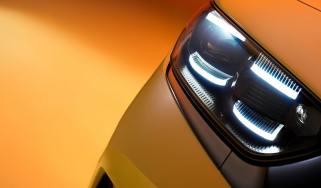
New Ford Capri teased ahead of July reveal – but it’s not a sports car
Most Popular

New Smart #5 Brabus is a 637bhp far cry from the brand’s city car past

Best car leasing deals 2025: this week’s top PCH offers
Tips & advice

Car dashboard warning lights: what does each symbol mean?

Electric car charging stations: public networks, charger types, apps and maps




